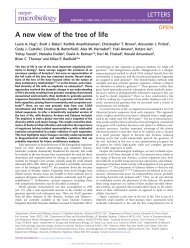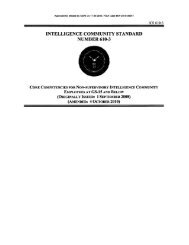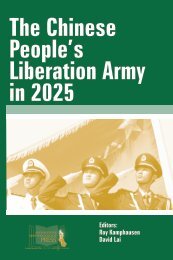The Joint Force in a Contested and Disordered World
JCS-JOE-2035
JCS-JOE-2035
You also want an ePaper? Increase the reach of your titles
YUMPU automatically turns print PDFs into web optimized ePapers that Google loves.
crim<strong>in</strong>al activities cont<strong>in</strong>ues to blur, the transactional connections between a wide-range of<br />
unlawful organizations is also likely to blur the dist<strong>in</strong>ction between law enforcement <strong>and</strong> military<br />
operations. <strong>The</strong> <strong>Jo<strong>in</strong>t</strong> <strong>Force</strong> may f<strong>in</strong>d it more difficult to dist<strong>in</strong>guish between allies <strong>and</strong> adversaries,<br />
<strong>and</strong> determ<strong>in</strong>e who really matters, who to engage, <strong>and</strong> who to support.<br />
<strong>The</strong> Rise of Privatized Violence<br />
States will f<strong>in</strong>d it <strong>in</strong>creas<strong>in</strong>gly difficult to ma<strong>in</strong>ta<strong>in</strong> a monopoly on the use of force. Private <strong>and</strong><br />
non-state groups, <strong>in</strong> the absence of strong or legitimate states, will <strong>in</strong>creas<strong>in</strong>gly turn to violence to<br />
advance their political, social, ideological, or economic goals. Sub-state <strong>and</strong> transnational actors<br />
will be enabled by the ability to rapidly share <strong>in</strong>formation through mobile devices <strong>and</strong> associated<br />
social media platforms. Collective action <strong>and</strong> popular movements, which once took once took<br />
months or years to build, will be catalyzed <strong>in</strong> hours. Small determ<strong>in</strong>ed groups or even lone<br />
radicalized <strong>in</strong>dividuals will cont<strong>in</strong>ue to wield enormous <strong>in</strong>fluence us<strong>in</strong>g “off grid” mesh networks<br />
to disrupt the political <strong>and</strong> social order of a nation.<br />
<strong>The</strong> rise of privatized violence is likely to result from several important trends:<br />
Adaptive irregular/sub-state adversaries. Adversaries will cont<strong>in</strong>ue develop<strong>in</strong>g capabilities<br />
to avoid or withst<strong>and</strong> U.S. technological overmatch. Many crim<strong>in</strong>al <strong>and</strong> terrorist groups are<br />
likely to comb<strong>in</strong>e relatively cheap, accessible, <strong>and</strong> potentially disruptive technologies – such<br />
as social media, smartphones, 3D pr<strong>in</strong>t<strong>in</strong>g, robotic <strong>and</strong> autonomous systems – to degrade or<br />
even defeat U.S. systems <strong>in</strong> the future.<br />
Disruptive manufactur<strong>in</strong>g technologies <strong>and</strong> the urban arsenal. <strong>The</strong> proliferation of<br />
technology <strong>and</strong> a wide range of manufactur<strong>in</strong>g capabilities <strong>in</strong> many urban areas will likely<br />
cont<strong>in</strong>ue over the next two decades <strong>and</strong> might lead to novel advances, to <strong>in</strong>clude pervasive<br />
<strong>in</strong>telligence, surveillance, <strong>and</strong> reconnaissance <strong>in</strong>struments <strong>and</strong> relatively cheap <strong>and</strong> simple,<br />
yet effective strike assets such as 3D pr<strong>in</strong>ted drones or sophisticated IEDs.<br />
Weaponization of commercial technologies. Over the next two decades, a greater number of<br />
people will become connected <strong>and</strong> beg<strong>in</strong> to take advantage of mobile technologies. Driven<br />
largely by expected advances <strong>in</strong> computerization, m<strong>in</strong>iaturization <strong>and</strong> digitization, potential<br />
adversaries will likely have greater access to more sophisticated weaponry that does not<br />
require sophisticated users to effectively employ.<br />
Transnational crim<strong>in</strong>al organizations, terrorist groups, <strong>and</strong> other irregular threats are likely to<br />
exploit the rapid spread of advanced technologies to design, resource, <strong>and</strong> execute complex attacks<br />
<strong>and</strong> comb<strong>in</strong>e many complex attacks <strong>in</strong>to larger, more susta<strong>in</strong>ed campaigns. Potential adversaries<br />
might leverage commercially available cell phone <strong>and</strong> network<strong>in</strong>g capabilities to issue real-time<br />
propag<strong>and</strong>a through social media that portrays the <strong>Jo<strong>in</strong>t</strong> <strong>Force</strong> <strong>in</strong> a negative manner <strong>and</strong> highlights<br />
actual or perceived <strong>in</strong>justices. Or, the <strong>Jo<strong>in</strong>t</strong> <strong>Force</strong> might be confronted by a more lethal battlefield<br />
as potential adversaries use basic but effective strike assets to impose significant costs on units<br />
conduct<strong>in</strong>g urban combat operations. However, <strong>in</strong> the future the <strong>Jo<strong>in</strong>t</strong> <strong>Force</strong> could leverage<br />
technology to disrupt, deny, <strong>and</strong> defeat these systems, us<strong>in</strong>g many of the same asymmetric<br />
techniques that adversaries currently employ aga<strong>in</strong>st the United States.<br />
14











